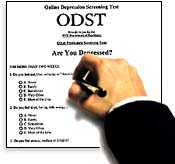
|

Antidepressants Linked to Breast Cancer
A recent survey of 20 major medical and psychiatric journals by a California newspaper found every advertisement for antidepressants targeted women.
A report to the American Psychological Association, entitled “A Woman’s Mental Health Agenda,” noted that 73 percent of all psychiatric drugs, including antidepressants, are prescribed to females.
This takes on the color of an impending national disaster in light of an April 1996 article in the American Journal of Psychiatry which links psychiatric drugs, particularly antidepressants, to breast cancer.
Breast cancer is the most common malignant disease among women and often leads to death. It is estimated that 12 percent of women will be diagnosed with it during their lifetime and that 25 percent of those will die from it.
With armies of lavishly equipped sales and marketing personnel swarming around America’s medical doctors, and barrages of multi-media advertisements aimed at consumers, the psychiatric architects of the depression war seek to get as many people as possible labeled “depressed.”
|
|
A team of three medical researchers, led by Uriel Halbreich, M.D., of New York University at Buffalo, New York, discovered that between 1987 and 1991, breast cancer in psychiatric patients treated with antidepressants was 9 1/2 times greater than in the general U.S. population for women aged 50 and older. The psychiatric patients’ ages were comparable, ranging upward from 40.
For this study, the researchers reviewed mammograms and charts of 275 female patients.
They also compared these 275 psychiatric patients to 928 women of similar age at a general hospital radiology clinic. The findings showed that breast cancer in women treated with antidepressants was 3 1/2 times greater than the radiology patients.
A national expert on depression, Professor David O. Antonuccio of the University of Nevada School of Medicine, applauded this study and condemned the use of antidepressants.
“These drugs have been considered carcinogens in humans,” he said. Pointing to the paucity of research in this area, he noted, “This is the first study I have seen.”
Given that women are the primary consumers of antidepressants – they are prescribed these drugs almost three times as often as men are – the data revealed in the breast cancer study should logically result in psychiatrists and physicians curtailing prescriptions until further studies are done. Yet, the opposite is true, as sales of antidepressants to women continue to climb.
With baseless criteria for depression pushed by the American Psychiatric Association and high-powered advertising campaigns hawking antidepressants as the cure for the blues, it is no wonder that the National Task Force on Women and Depression warned that misdiagnosis and over prescription are severe problems.
Vast Waste

At the center of it all, the federal government pours enormous sums into “studies.” According to former NIMH director Rex Cowdry, the NIMH from 1994 until the end of 1996 will have spent a total of more than $500 million on depression alone.
Expenditures by NIMH do not factor in money doled out by an alphabet soup of other federal agencies, such as the National Institute for Drug Abuse, for their own depression studies.
Consider one NIMH grant, begun in 1988, which will continue through 1997, for a study conducted at the Oregon Research Institute by Hyman Hops.
Since 1988, this study has soaked $2,000,385 of taxpayers’ money. Does it take $2 million to “videotape interactions between young adults and their parents, friends and sex partners"? Obviously not.
Nor should it require eight years and $2 million to get questionnaires answered about “social, psychological, academic behavior, work adjustment, parental contact, and family and peer relationships.”
Moreover, unless someone with authority over the purse strings comes to their senses, this NIMH-funded waste will continue for nearly two more years covering ground that previous studies have trod many times before. The cost of this study in 1995 was $627,410. Judging from the steady increase of funds to the project since 1993, the last two years of the grant will easily consume another $1.3 million or more.
This is not a study of depression among youth – it is a five-star meal ticket for people in the psychiatric industry.
A search of NIMH data bases under the term “depression studies” turned up thousands of individual grants, funded for up to eight years. The average amount per year per grant in one data base – containing 729 individual grants – was roughly $150,000. Billions of dollars in research grants certainly have not impacted upon the staggering depression figures the psychiatric industry announces through the media.
One grant to study depression has been running for 20 years. Over the past six years alone, this grant has been worth $801,435 to the researchers.
Another grant to study depression has run 10 years, with two more years to go. The expense to the taxpayer for the four years of this study, from 1992 to 1995, is $1,999,281. (For descriptions of the contents of such studies, see “Psychiatry’s $40,000,000,000 Fraud”).
At Taxpayer Expense
Subsidized unwittingly by the taxpayer, depression is indeed a growth industry.
The American Psychiatric Association, NIMH and pharmaceutical companies claim that ever-higher numbers of Americans suffer from it.
The psychiatric industry continually asks for yet more money to study the problem.
And the government dutifully forks it over. In 1994 the NIMH received $158 million to “study” depression. The NIMH budget for depression studies in 1996 is nearly $200 million. But if drugs are so wonderful, why is so much additional money needed for further research?
“These drugs have been considered carcinogens in humans.”
– Professor David O. Antonuccio
|
|
The simple answer is that additional federal funds poured into psychiatric research are not needed and only exacerbate endemic problems of waste and fraud.
In 1992, U.S. Representative Pat Schroeder, then chair of the House Select Committee on Children, Youth and Families, summarized the abuses and criminality that characterize institutional psychiatry – kept alive in large measure by government infusions of cash for “research.” Her words regarding what she condemned as “unethical and disturbing practices” in psychiatry ring even more true today:
“Our investigation has found: that thousands of adolescents, children, and adults have been hospitalized for psychiatric treatment they didn’t need; that hospitals hire bounty hunters to kidnap patients with mental health insurance; that patients are kept against their will until their insurance benefits run out; that psychiatrists are being pressured by the hospitals to alter their diagnosis to increase profits; that hospitals ‘infiltrate’ schools by paying kickbacks to school counselors who deliver students; that bonuses are paid to hospital employees, including psychiatrists, for keeping the hospital beds filled; and that military dependents are being targeted for their generous mental health benefits.
“I could go on, but you get the picture. Clearly, this business of treating minds – particularly this big business of treating young minds has not policed itself, and has no incentive to put a stop to the kinds of fraudulent and unethical practices that are going on. This leads me to conclude that Federal and State oversight must be increased.”
A Solution
While no one can argue with the concept of better health care, funds to NIMH and organized psychiatry are not part of the solution. Psychiatrists are paid well to handle social problems. The worse the problem is, the more they expect to be remunerated. Why would such a vested interest want to eliminate the problems?
Churches have had far better success in dealing with mental health than have psychiatrists. After all, it was not until religions were cast aside by government-funded psychiatry that violence, drug abuse and moral decay began to ruin society.
Psychiatric treatments focus on man as an animal with no soul, to be manipulated or “modified” by drugs, electric shock and other means. Religions, on the other hand, acknowledge man as a spiritual being. They have traditionally helped to ameliorate problems and suffering and to provide hope.
Religions instill decency and moral standards to make living with our fellows more enjoyable and predictable. They were looked to for safety and support in times of need long before the psychiatrist came along.
One would do better to consult a member of the clergy – or a relative or trusted friend – for advice following the loss of a loved one or at other times of need. As innumerable case histories have attested, entering the door to a psychiatrist’s office is entering “a world where great harm is possible.”
We would also collectively slash funding for psychiatric “research.”
“In my opinion,” stated psychiatrist and author Thomas Szasz, “the ‘mental health’ – in the sense of spiritual well-being – of Americans cannot be improved by slogans, drugs, community mental health centers, or even with billions of dollars expended on a ‘war on mental illness.’ ... The best, indeed, the only, hope for remedying the problem of ‘mental illness’ lies in weakening – not in strengthening – the power of Institutional Psychiatry.”
|

|









